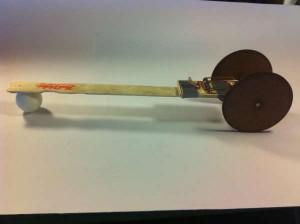Mechanical and Electrical Power, Work, and Energy
All things that move need some source of energy. This energy may be as simple as using gravity (like how a slinky can walk down stairs), or as complex as an internal combustion engine. Power can also be supplied by a person, by cranking a handle or pedaling a bike. Our bodies turn the chemical energy from food we eat into mechanical energy so we can run and jump. Motors turn electrical energy into mechanical energy so we can make things that move and spin. In this chapter we’ll discuss how power, work, and energy are related, identify sources of power, then highlight practical examples of putting these sources to work.
Correction: On page 101 of the paperback version, it says that alternating current fluctuates between 0V and 120V. It actually fluctuates from about 169 V below ground to 169 V above ground. It supplies the same average power as a 120 V DC source, which is why it is called 120 V AC. — Thanks to William E. Wagner III’s comment on Amazon!
Project 5-1: Mousetrap powered car
See my Mousetrap Powered Car Instructable for full documentation! You can download the wheels template (or a hub for a CD wheel) for free on Thingiverse or order the parts directly from Ponoko.
